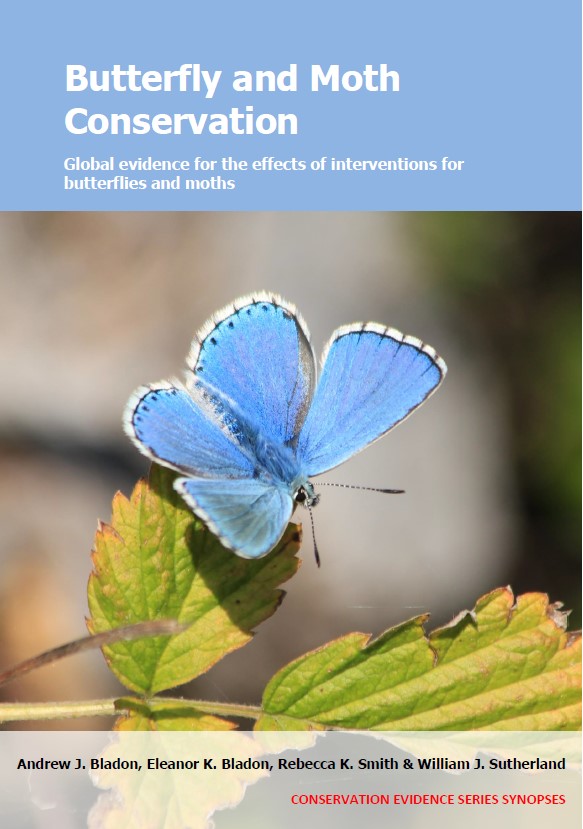Actions to conserve biodiversity
We have summarised evidence from the scientific literature about the effects of actions to conserve wildlife and ecosystems.
Review the evidence from the studies
Not sure what Actions are? Read a brief description.
Search for evidence
e.g. "frogs chytrid"
152 Actions found
Refine
Hide
152 Actions found
Download Actions
| 0 selected |
|
Order results by:
| Action | Effectiveness | Studies | Category | |
|---|---|---|---|---|
|
Legally protect habitat Action Link |
Evidence not assessed | 10 |
|
|
|
Retain connectivity between habitat patches Action Link |
Awaiting assessment | 3 |
|
|
|
Retain buffer zones around core habitat Action Link |
No evidence found (no assessment) | 0 |
|
|
|
Practise ‘wildlife gardening’ Action Link |
Evidence not assessed | 4 |
|
|
|
Protect or restore brownfield or ex-industrial sites Action Link |
No evidence found (no assessment) | 0 |
|
|
|
Protect greenfield sites or undeveloped land in urban areas Action Link |
Awaiting assessment | 2 |
|
|
|
Establish “green infrastructure” in urban areas Action Link |
Awaiting assessment | 1 |
|
|
|
Plant trees to reduce temperatures in cities Action Link |
No evidence found (no assessment) | 0 |
|
|
|
Apply ecological compensation for developments Action Link |
Evidence not assessed | 2 |
|
|
|
Require developers to complete Environmental Impact Assessments when submitting planning applications Action Link |
No evidence found (no assessment) | 0 |
|
|
|
Alter mowing regimes on greenspaces and road verges Action Link |
Evidence not assessed | 7 |
|
|
|
Plant parks, gardens and road verges with appropriate native species Action Link |
Awaiting assessment | 8 |
|
|
|
Remove or change turbine lighting to reduce insect attraction Action Link |
No evidence found (no assessment) | 0 |
|
|
|
Change turbine colour to reduce insect attraction Action Link |
No evidence found (no assessment) | 0 |
|
|
|
Reduce the size of surface features when prospecting for or extracting underground products Action Link |
Awaiting assessment | 1 |
|
|
|
Provide training for land managers, farmers and farm advisers Action Link |
Evidence not assessed | 1 |
|
|
|
Raise awareness amongst the general public to promote conservation actions Action Link |
No evidence found (no assessment) | 0 |
|
|
|
Increase consideration of butterflies and moths in international, national and local conservation plans Action Link |
No evidence found (no assessment) | 0 |
|
|
|
Use signs and access restrictions to reduce disturbance Action Link |
No evidence found (no assessment) | 0 |
|
|
|
Restrict recreational activities to particular areas Action Link |
No evidence found (no assessment) | 0 |
|
|
|
Design the route of roads to maximize habitat block size Action Link |
No evidence found (no assessment) | 0 |
|
|
|
Minimize road lighting to reduce insect attraction Action Link |
No evidence found (no assessment) | 0 |
|
|
|
Use infrastructure to reduce vehicle collision risk along roads Action Link |
Awaiting assessment | 1 |
|
|
|
Restore or maintain species-rich grassland along road/railway verges Action Link |
Evidence not assessed | 8 |
|
|
|
Manage land under power lines for butterflies and moths Action Link |
Awaiting assessment | 6 |
|
Download Actions
| 0 selected |
|

Butterfly and Moth Conservation - Published 2023
Butterfly and Moth Synopsis
Watch this search
If you are familiar with RSS feeds, please click the button below to retrieve the feed URL:
RSS feed for this searchIf you are unfamiliar with RSS feeds, we would suggest reading this BBC article.
Unfortunately, due to the number of feeds we have available, we cannot provide e-mail updates. However, you could use tools such as Feed My Inbox to do this for you.
What are 'Individual studies' and 'Actions'?
Individual studies
An individual study is a summary of a specific scientific study, usually taken from a scientific journal, but also from other resources such as reports. It tells you the background context, the action(s) taken and their consequences.
If you want more detail please look at the original reference.
Actions
Each action page focuses on a particular action you could take to benefit wildlife or ecosystems.
It contains brief (150-200 word) descriptions of relevant studies (context, action(s) taken and their consequences) and one or more key messages.
Key messages show the extent and main conclusions of the available evidence. Using links within key messages, you can look at the paragraphs describing each study to get more detail. Each paragraph allows you to assess the quality of the evidence and how relevant it is to your situation.
Where we found no evidence, we have been unable to assess whether or not an intervention is effective or has any harmful impacts.





)_2023.JPG)














